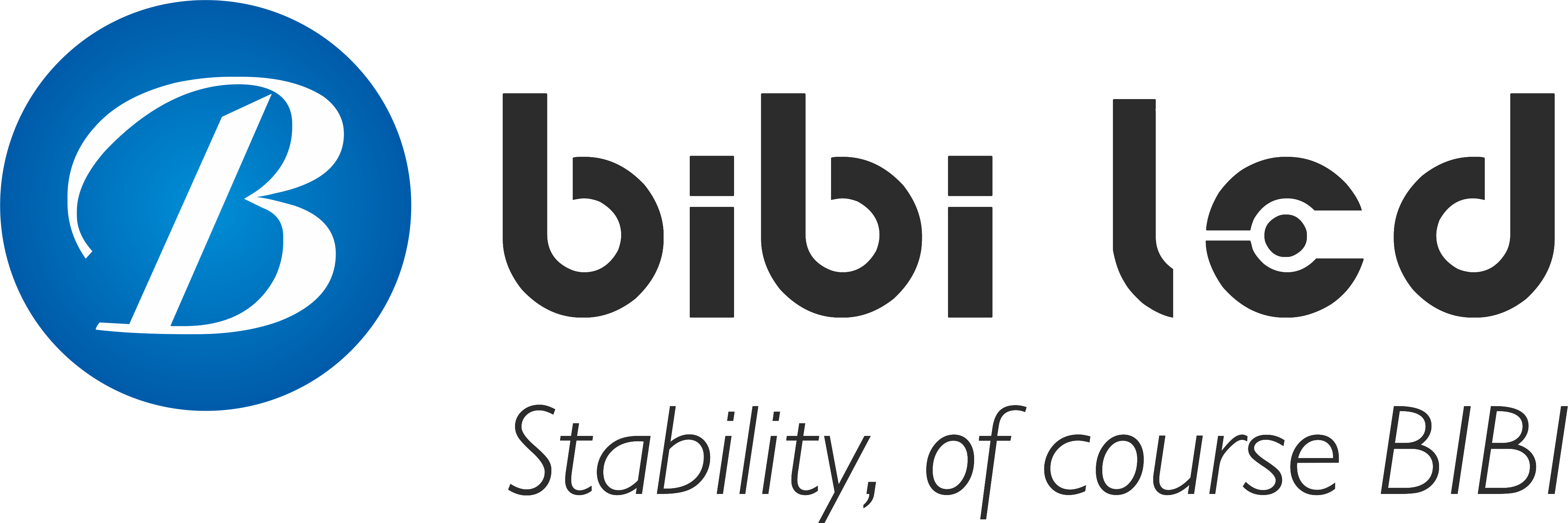소개
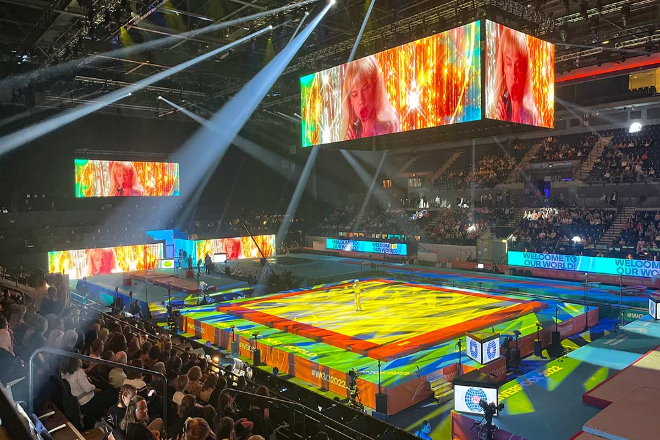
In the fiercely competitive TV program market, how to catch the audience’s attention?
Traditional 단계 settings and shooting techniques seem to be unable to meet the audience’s growing visual needs.
The creative application of 발광 다이오드 표시 스크린, with their powerful functions and unlimited creative potential, has become a “secret weapon” in TV program production. So, how can LED display screens inject new vitality into TV programs?
목차
1. Why do TV program production like to use the creative application of LED display screens?
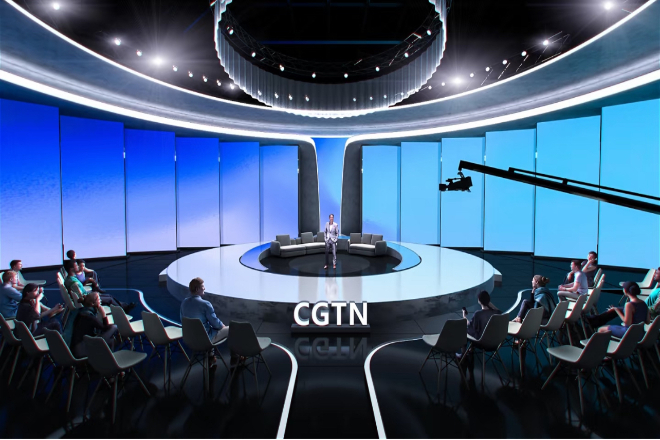
The LED display screen is used in TV programs, first of all, because it looks very comfortable.
This thing has a high 명도. No matter how bright the studio lights are, the picture will not be blurred and unclear.
Moreover, its contrast is particularly good, black and white are clear, the colors are very bright, and the details can be seen clearly.
그만큼 해결 is also very high, the picture is very delicate, and there will be no graininess.
Most importantly, its color reproduction is very strong. No matter what color it is, it can be restored very realistically, just like seeing it with your own eyes.
This display effect is perfect for TV programs that pursue visual effects.
The splicing method of LED display screens is very flexible, just like building blocks.
You can splice screens of various sizes and shapes according to the size and shape of the studio, and you can assemble them however you want.
Moreover, the current technology is very mature, and the spliced pictures are completely seamless and look very natural.
In addition to splicing, LED display screens can also be customized.
The program production team can make any background they want according to the theme of the program, such as ancient style, modern style, and science fiction.
This flexibility gives program producers more creative space.
LED display screens are simply the “creative artifact” of TV programs. It can easily create various scenes, such as outdoor scenery in the studio, or virtualize a future world.
In variety shows, this scene switching is particularly useful, which can make guests and audiences feel that they are really somewhere, and they feel particularly involved.
Moreover, it can also interact with the audience, such as when voting on the spot or playing games, the picture can be displayed in real time, making the audience more involved.
This kind of creativity and interaction cannot be achieved by traditional backgrounds.
In TV program production, time is money. The advantage of an LED display is that it can quickly switch scenes.
Compared with the previous method of changing background boards, it only needs to move fingers to change a picture in a few seconds, which greatly saves time.
In addition, during virtual shooting, the LED display can preview the background effect in real time, and the production team can see the effect immediately.
If there is a problem, it can be corrected immediately without worrying about problems in post-production.
This efficiency makes program production smoother and saves a lot of costs.
LED display has a wide range of applicability and can be used for any type of program.
News programs can use it as a simple and atmospheric background, variety shows can use it to create a joyful atmosphere, and reality shows can use it to simulate various scenes.
In addition, it supports multiple signal sources, whether it is high-definition video, a computer screen or a live camera screen, it can be easily connected.
This versatility allows program producers not to worry about equipment incompatibility and is particularly convenient to use.
2. What are the creative applications of LED display screens in TV program production?
1). Change the background at any time
In TV programs, the biggest advantage of LED display screens is that the background can be changed quickly.
For example, when a singer sings on the stage, the background can instantly change from the starry sky to fireworks, or from the forest to the sea.
This change is particularly suitable for evening parties or music programs, which can make the audience’s eyes light up.
For example, the 2025 Spring Festival Gala uses LED display screens combined with naked eye 3D, ultra-high-definition visual projection and other technologies to create an ever-changing “Ruyi” space.
In addition, LED display screens are often used as virtual backgrounds in TV dramas to quickly switch scenes and enhance the compactness of the plot.
2). The shape of the 단계 can also change
LED display screens can not only change the picture, but also be assembled into various shapes. It can be bent into a ring or assembled into a three-dimensional box.
On the stage of some variety shows, the LED screen will rise and fall like a Transformer, turning the stage into a space full of surprises.
This design not only makes the audience feel fresh, but also makes the performances of the guests more interesting.
For example, the main stage of the 2025 Spring Festival Gala is connected to the audience seats.
Through the 5m×5m LED cube lifting module, combined with a variety of technologies, a rich spatial effect is created.
In the variety show “National Treasure”, a variety of stage designs, such as giant LED ring screens and projection gauze boxes, are used to bring a magnificent stage visual effect.
3). Audiences can also participate
In programs where the audience participates, LED display screens are a good interactive tool.
For example, in game shows, the audience’s voting results and answering scores can be displayed on the screen in real time, and everyone can see them at a glance.
Some programs even allow the audience to interact with the screen through their mobile phones, such as voting for the next game link or cheering for their favorite players, and the screen will immediately give feedback.
This kind of interaction makes the audience more involved and the program more lively.
4). The virtual world can also be on
Now, some programs use cool virtual reality technology, and the LED display screen is like a “portal” that brings the audience and guests into the virtual world.
For example, on the stage, actors can interact with virtual animals and plants or perform in a virtual ancient palace.
The scene that the audience sees is like it really exists. This effect is particularly shocking and completely breaks the limitations of traditional stages.
5). News can also be more intuitive
In news programs, LED display screens can display relevant pictures, videos, charts, and even pull out maps of the places where the news occurred.
For example, when the anchor talks about economic data, the screen directly displays a bar chart, and the audience understands it at once.
This intuitive display method makes news programs more beautiful and easier to understand.
For example, Xinhua News Agency’s New Cube Studio uses 5 LED screens to create an immersive studio environment, presenting realistic virtual scenes, and enhancing the fun and visibility of news reports.
6). Super cool visual effects
LED display screens can also be combined with some super cool technologies, such as holographic projection or naked eye 3D.
For example, a virtual singer suddenly appears on the stage and sings with a real singer, or the audience can see a 3D effect picture without wearing glasses.
This kind of visual effect is particularly suitable for programs that pursue cool effects, which can make the audience feel particularly fresh.
3. Creative ways to increase the appeal of LED screens in TV program production
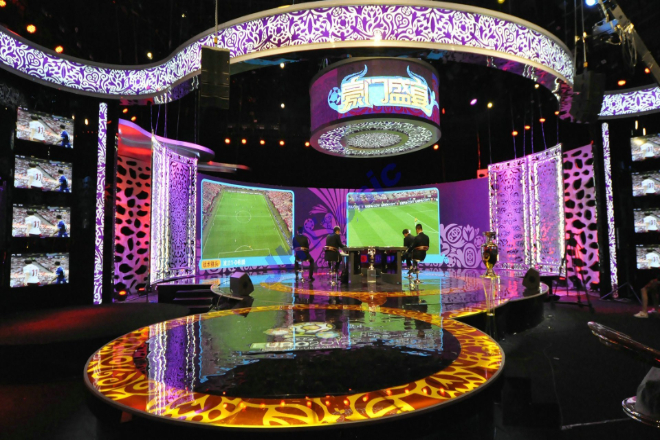
1). Play with background images
In simple terms, it is to use the LED screen as a large canvas and draw whatever you want. For example, when a singer sings, the background can be the sea, the starry sky, or a sea of flowers.
Moreover, the picture can also move with the rhythm of the song, such as lyrics floating across the screen, or small animals running around in the picture.
When the audience looks at this kind of picture, they will feel very fresh, as if they have entered the world of the song.
2). Funny screen shape
LED screens do not have to be square; they can be assembled into various strange shapes. For example, they can be assembled into a large ring or like a pyramid.
You can even assemble it into a three-dimensional box, where the guests perform inside, and the audience looks like they are looking at a fantasy box from the outside.
This unique shape can catch the audience’s attention at once.
3). The audience can also “be on camera”
In interactive programs, the audience’s sense of participation is particularly important. The LED screen can display the audience’s voting results in real time, or directly type the audience’s comments on the screen.
For example, when the audience votes for the contestants, the vote count changes can be seen on the screen immediately.
The audience will feel particularly excited when they see their choices being “seen”.
This kind of interaction makes the audience no longer a spectator, but a part of the show.
4). “Crossing” virtual scenes
Nowadays, technology is so powerful that LED screens can be combined with virtual reality technology to create virtual scenes.
For example, on the stage, actors can dance with virtual dinosaurs or perform in virtual ancient palaces.
The images seen by the audience are like real existence, which feels very magical. This “crossing” effect can bring the audience to a completely different world.
5). “Moving” screens
LED screens can be spliced into many pieces, and each piece can display different pictures.
For example, on the stage, the screen can be divided into several pieces, each piece displays a different picture, or the screen can be raised and lowered and rotated.
For example, in the evening party, the screen rises and falls with the rhythm of the music, or the picture suddenly splits from the middle, and the guests walk out from the middle. This dynamic effect is particularly cool.
6). Naked-eye 3D is super cool
Now, some LED screens can produce naked-eye 3D effects, and the audience can see three-dimensional images without wearing glasses.
For example, a virtual dragon appears on the stage, and the dragon’s scales can be seen clearly, as if it is really flying on the stage.
This effect is particularly suitable for evening parties or programs with a strong sense of technology, which can make the audience feel particularly fresh.
7). Lighting and sound effects work together
LED screens can work with lighting and sound effects. For example, in a music program, the screen image moves with the rhythm of the music, the lights also flash, and the sound effects are more shocking.
The audience’s vision and hearing are stimulated together, and the feeling is particularly refreshing, and the program is naturally more attractive.
In short, the LED screen is like a super fun tool. As long as it is used correctly, it can make the program super interesting and super attractive!
4. Things worth noting
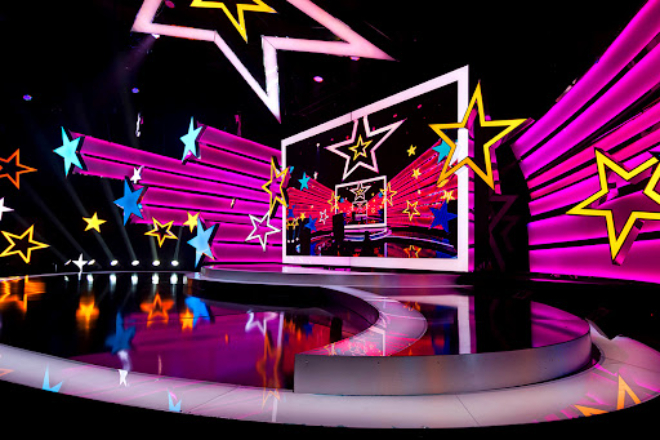
1). Test the screen effect in advance
Before officially recording or live broadcasting, be sure to test the effect of the LED display in advance.
Different programs have different requirements for the picture.
For example, some programs require high-contrast pictures, while others require soft color transitions.
Advance testing can ensure that the screen’s picture quality meets the program’s requirements, and can also promptly detect and solve possible technical problems, such as screen flickering and color deviation.
2). Pay attention to the 명도 and contrast of the screen
The brightness and contrast of the LED display are very important. If the screen is too bright, it may be dazzling or reflect too much under strong light.
If it is too dark, it may not be clear. Contrast is also critical. High contrast can make the picture more layered, but too high contrast may make the picture look too strong.
According to the program scene and shooting environment, adjust the brightness and contrast of the screen to make the picture look comfortable and clear.
3). Consider the 해결 of the screen
The resolution determines the clarity of the picture. If the program needs to show delicate picture details, such as close-ups of people or complex patterns, a high-resolution LED display is required.
If the resolution is not enough, the picture may appear blurry or grainy. When choosing a screen, determine the resolution based on the specific needs of the program.
4). Make sure the screen content matches the program content
The content on the screen must be closely matched with the program content. For example, in a music program, the screen image must match the style and rhythm of the song.
In news programs, the charts and data on the screen must be accurate. If the screen content is inconsistent with the program content, it may confuse or distract the audience.
5. 결론
Through the introduction of this article, we can see that the application of LED display screens in TV program production has completely changed the limitations of traditional stages.
From flexible splicing to real-time interaction, from virtual scenes to naked-eye 3D, it brings an unprecedented visual feast to the audience. However, this is just the beginning.
마지막으로 LED 디스플레이 화면에 대해 더 알고 싶다면, 우리에게 연락해주세요.
